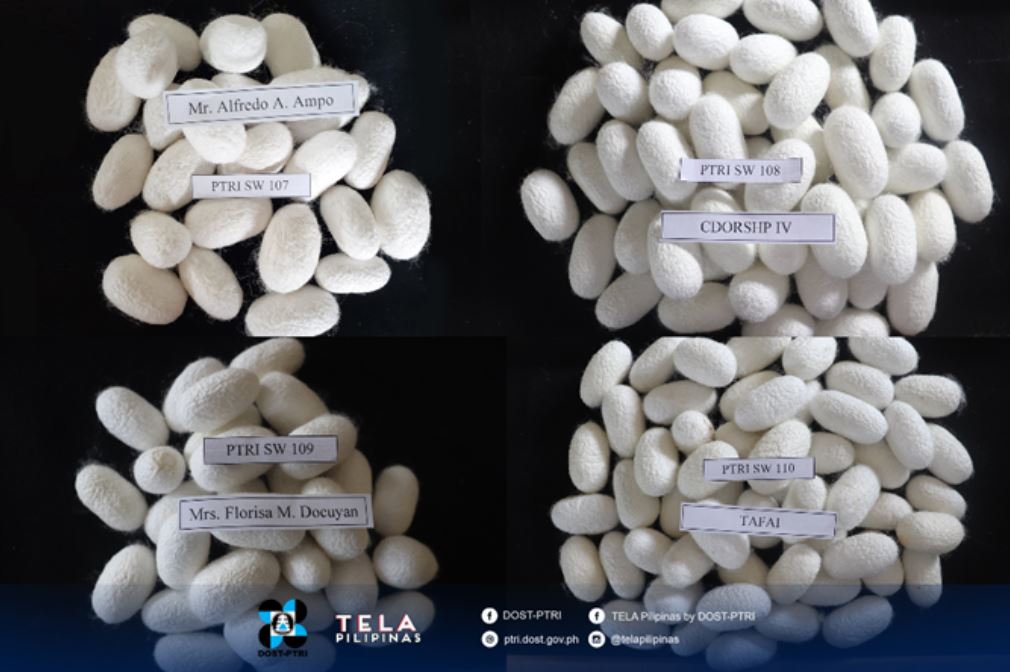Philippines develops 4 new silkworm hybrids

The Philippines has developed 4 new Philippine silkworm hybrids that will be used in Mindanao silk hubs.
The four new Philippine silkworm hybrids namely PTRI SW 107, 108, 109, and 110 were successfully reared by the pioneering Silk Cocoon Production Hubs (Silk Hubs) in Misamis Oriental through the Silk Research and Innovation Center (SRIC) of the Philippine Textile Research Institute of the Department of Science and Technology (DOST-PTRI).
The presence of various hybrid silkworms means new strains of cocoon production for silk yarns and fabrics. As compared to the parent lines, these hybrids have higher productivity as they are mostly healthier, able to adapt to their environment and have better cocoon and shell weight.
These silkworm hybrids came from the silk hybridization of Philippine Silkworm parent lines from the 85 lines in the PTRI Silk Germplasm also from the DOST-PTRI SRIC. Significantly, these performed better in terms of larval characteristics to cocoon properties in the lab-scale trials, that is why they were rolled out into the Silk Hubs to verify their performances.
The hybrids completed the first out of three cycles of rearing in the field-verification stage. These cycles are important in order to have reliable data as to the consistency, grading, and classification of cocoons per location at different times. To classify the grade of silk cocoons, there are parameters considered, namely: single cocoon weight, cocoon shell percentage, and the live pupa ratio. These will be the basis for cocoons to be graded as Class AA, A, B, or C.
For the first cycle, the group of women-silk rearers under CDORSHP-IV produced cocoons with 21% cocoon shell percentage and 1.62 g average cocoon weight. With only two parameters considered, it could have been classified as Class A, with the highest class of cocoon. However, the third parameter being the live pupae percentage, unfortunately dragged the rating to Class B.
Considering that these Silk Hubs have just started, their succeeding live pupae percentage is expected to improve with proper management and experience. Grade A cocoons can be sold at P350/kg, while Grade AA will cost P400/kg, thus providing a mechanism to foster good rearing practices to maximize cocoon quality and productivity.
There will be two more rearing activities in 2021 using the same hybrids in the same locations that will provide additional information on the effect of the rearing climate. These will complete the field-verification activity before the hybrids are officially launched for commercial use by the end of the year.
The pioneering Silk Hubs are: 1) Tinipigan Agro-forestry Association, Inc. (TAFA Inc.) in Barangay Tagpangi, and 2) Cagayan de Oro (CDO) Resettlement and Socialized Housing Project IV (CDORSHP-IV) in Barangay Balubal. These groups were joined by two other hubs manned by two silk cocoon producers, 3) Florisa Docuyan of Barangay Ane-i and 4) Alfredo A. Ampo of Barangay Panampan (1,000 masl).
The control set was reared at the PhilSilk Center serving as the fifth location. Generally, they are located in four different locations in Northern Mindanao, specifically in Cagayan de Oro City and Misamis Oriental. These locations established the performance of the hybrids as a function of altitude.
The silk innovation activities in Northern Mindanao are supported by the strong partnership of DOST-PTRI with the DOST-Misamis Oriental, Provincial Agriculture Office (PAGRO) Misamis Oriental, and CDO City Housing Urban Development Division of the CDO local government.
DOST PTR has put the spotlight on the country’s tropical fabric and is also working with the Cagayan Valley textile innovation facility to promote native natural fibers.
Good News Pilipinas is celebrating its 15th Anniversary in 2021 by giving away prizes! Subscribe to our Good News Pilipinas! TV YouTube channel and enter the raffle by sending us an email to editor@goodnewspilipinas.com saying what you like about our site.
The post Philippines develops 4 new silkworm hybrids appeared first on Good News Pilipinas.
Source: Good News Pilipinas



No comments